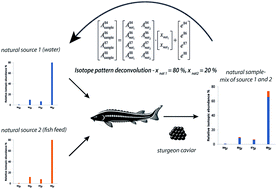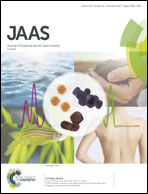Isotope pattern deconvolution of different sources of stable strontium isotopes in natural systems†
Abstract
Isotope pattern deconvolution (IPD) was used to determine the contribution of different Sr sources to the Sr isotopic composition of natural samples using the examples of sturgeon caviar and otoliths. For this purpose, the Sr isotopic composition of raw and salted sturgeon caviar, and otoliths as well as water, fish feed and salt (representing the assumed main contributors to the final isotopic composition of strontium in caviar) was analyzed using MC ICP-MS. The molar fractions and their uncertainties were determined using multiple-linear regression modeling and linear algebra calculations. The optimized approach was applied to caviar and otolith samples of different origin. The Sr isotopic composition of raw caviar and otoliths was formed of 79.8 ± 4.3% Sr from water and 20.2 ± 4.3% Sr from fish feed (1 SD, n = 5, between site variations). Deconvolution was possible even when the isotopic difference of the n(87Sr)/n(86Sr) between sources was less than 0.1%. The influence of salting on the isotopic composition of processed caviar accounted for up to almost 80% for samples treated with salt containing high concentrations of Sr. The developed methodology provides the basis for the accurate origin determination of samples by n(87Sr)/n(86Sr) isotopic-amount ratios, in cases, where the initial natural signature is modified by known additives.



 Please wait while we load your content...
Please wait while we load your content...